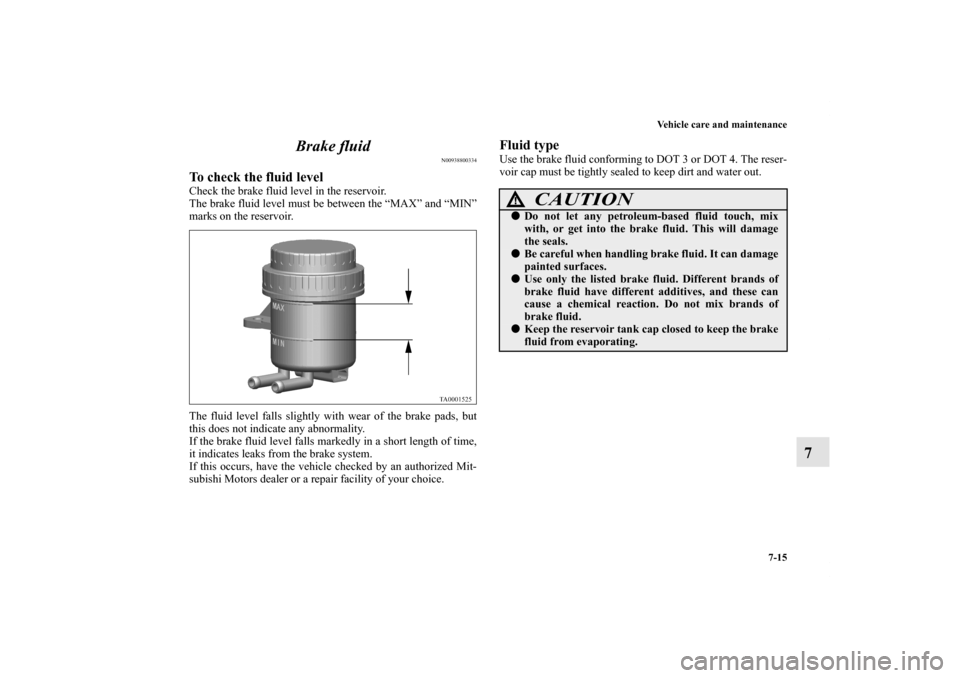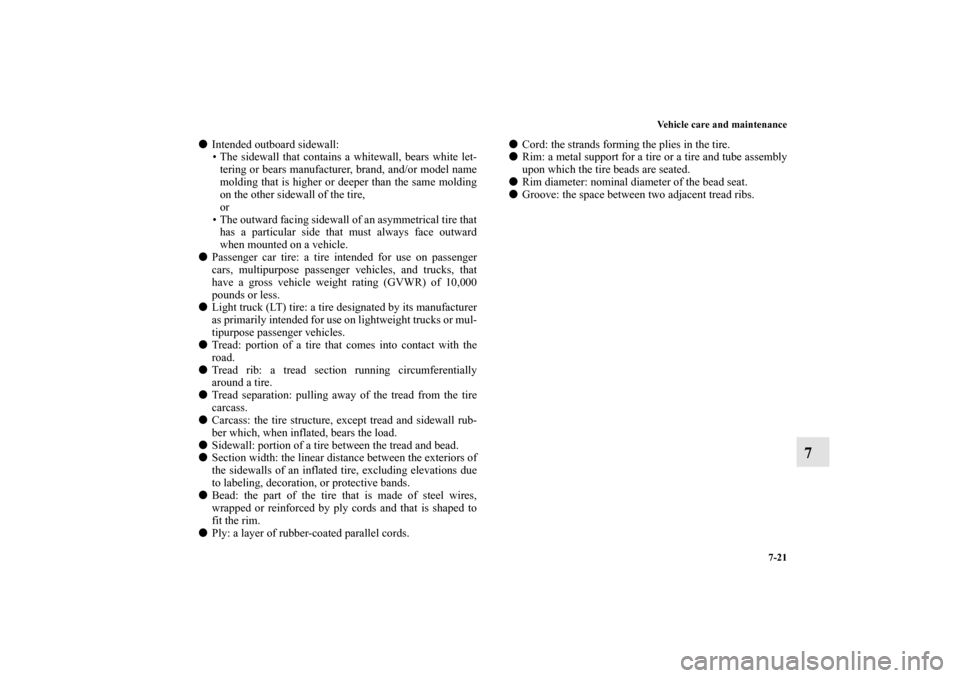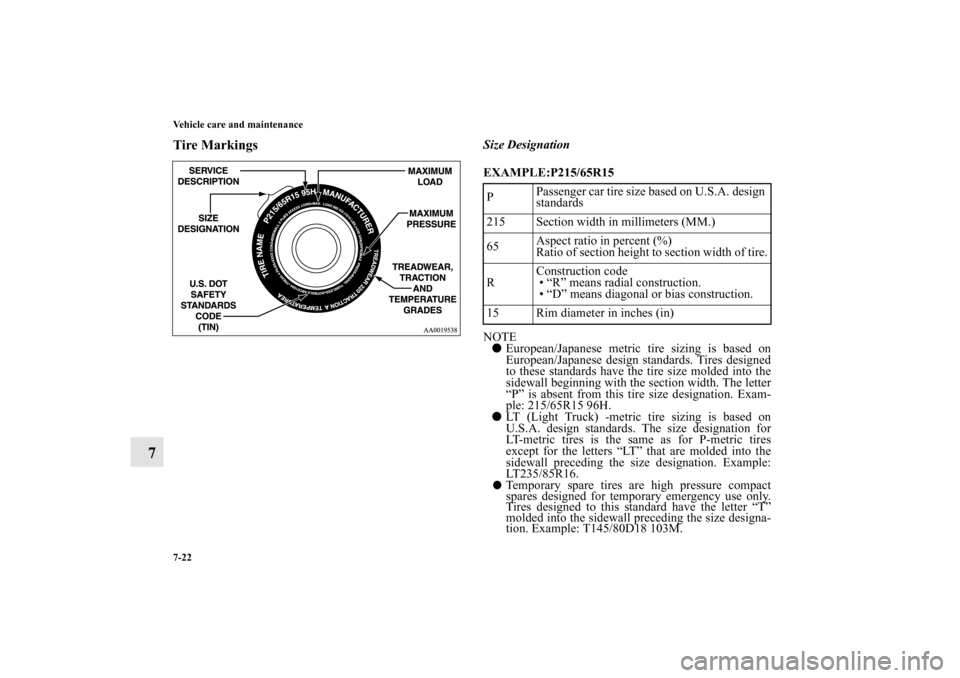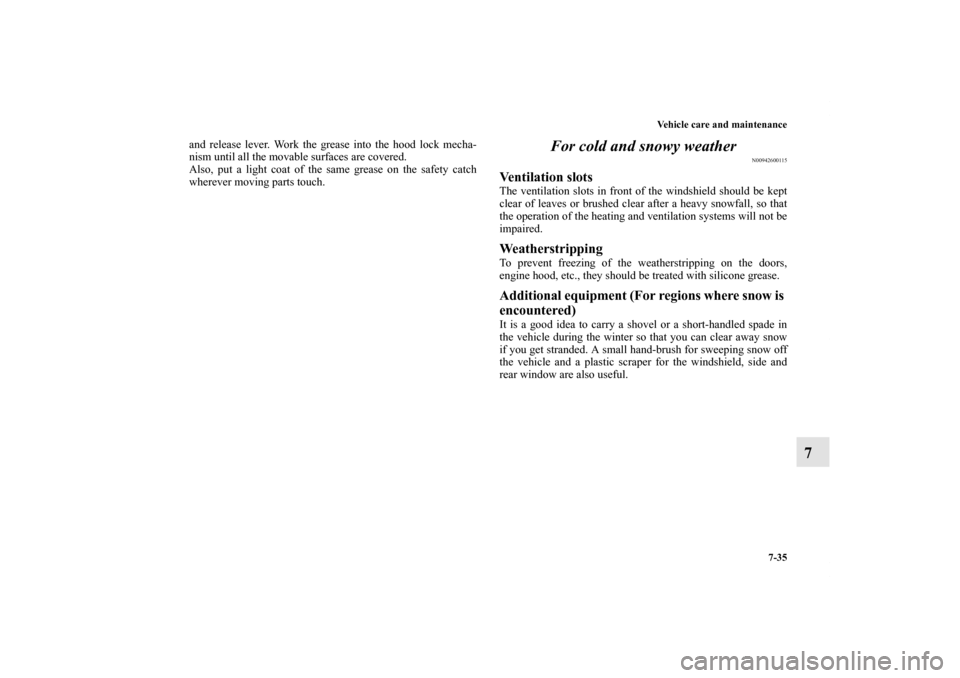Page 432 of 514
Vehicle care and maintenance
7-5
7
Support the engine hood with the hood prop. Insert the hood
prop securely in the opening under the hood marked with an
arrow.
To closeUnlatch the prop from the engine hood and put it back in its
retainer.
Slowly lower the engine hood about 8 inches (20 cm), then let
it drop from its own weight. NOTE�If this does not close the engine hood properly, drop it
again from a slightly higher position.
CAUTION
!�Always insert the support prop into the hole spe-
cially made for it. Propping the engine hood at any
other place could cause the prop to slip out and lead
to an accident. �The hood prop can fall out if the hood is lifted by a
strong wind.
CAUTION
!�Be careful not to trap your hands or fingers when
closing the engine hood.
BK0121600US.book 5 ページ 2010年4月12日 月曜日 午前10時39分
Page 442 of 514

Vehicle care and maintenance
7-15
7 Brake fluid
N00938800334
To check the fluid levelCheck the brake fluid level in the reservoir.
The brake fluid level must be between the “MAX” and “MIN”
marks on the reservoir.
The fluid level falls slightly with wear of the brake pads, but
this does not indicate any abnormality.
If the brake fluid level falls markedly in a short length of time,
it indicates leaks from the brake system.
If this occurs, have the vehicle checked by an authorized Mit-
subishi Motors dealer or a repair facility of your choice.
Fluid typeUse the brake fluid conforming to DOT 3 or DOT 4. The reser-
voir cap must be tightly sealed to keep dirt and water out.
CAUTION
!�Do not let any petroleum-based fluid touch, mix
with, or get into the brake fluid. This will damage
the seals.�Be careful when handling brake fluid. It can damage
painted surfaces.�Use only the listed brake fluid. Different brands of
brake fluid have different additives, and these can
cause a chemical reaction. Do not mix brands of
brake fluid.�Keep the reservoir tank cap closed to keep the brake
fluid from evaporating.
BK0121600US.book 15 ページ 2010年4月12日 月曜日 午前10時39分
Page 448 of 514

Vehicle care and maintenance
7-21
7
�Intended outboard sidewall:
• The sidewall that contains a whitewall, bears white let-
tering or bears manufacturer, brand, and/or model name
molding that is higher or deeper than the same molding
on the other sidewall of the tire,
or
• The outward facing sidewall of an asymmetrical tire that
has a particular side that must always face outward
when mounted on a vehicle.
�Passenger car tire: a tire intended for use on passenger
cars, multipurpose passenger vehicles, and trucks, that
have a gross vehicle weight rating (GVWR) of 10,000
pounds or less.
�Light truck (LT) tire: a tire designated by its manufacturer
as primarily intended for use on lightweight trucks or mul-
tipurpose passenger vehicles.
�Tread: portion of a tire that comes into contact with the
road.
�Tread rib: a tread section running circumferentially
around a tire.
�Tread separation: pulling away of the tread from the tire
carcass.
�Carcass: the tire structure, except tread and sidewall rub-
ber which, when inflated, bears the load.
�Sidewall: portion of a tire between the tread and bead.
�Section width: the linear distance between the exteriors of
the sidewalls of an inflated tire, excluding elevations due
to labeling, decoration, or protective bands.
�Bead: the part of the tire that is made of steel wires,
wrapped or reinforced by ply cords and that is shaped to
fit the rim.
�Ply: a layer of rubber-coated parallel cords.�Cord: the strands forming the plies in the tire.
�Rim: a metal support for a tire or a tire and tube assembly
upon which the tire beads are seated.
�Rim diameter: nominal diameter of the bead seat.
�Groove: the space between two adjacent tread ribs.
BK0121600US.book 21 ページ 2010年4月12日 月曜日 午前10時39分
Page 449 of 514

7-22 Vehicle care and maintenance
7
Tire Markings
Size Designation
EXAMPLE:P215/65R15
NOTE
�European/Japanese metric tire sizing is based on
European/Japanese design standards. Tires designed
to these standards have the tire size molded into the
sidewall beginning with the section width. The letter
“P” is absent from this tire size designation. Exam-
ple: 215/65R15 96H.
�LT (Light Truck) -metric tire sizing is based on
U.S.A. design standards. The size designation for
LT-metric tires is the same as for P-metric tires
except for the letters “LT” that are molded into the
sidewall preceding the size designation. Example:
LT235/85R16.�
Temporary spare tires are high pressure compact
spares designed for temporary emergency use only.
Tires designed to this standard have the letter “T”
molded into the sidewall preceding the size designa-
tion. Example: T145/80D18 103M.
PPassenger car tire size based on U.S.A. design
standards
215 Section width in millimeters (MM.)
65Aspect ratio in percent (%)
Ratio of section height to section width of tire.
RConstruction code
• “R” means radial construction.
• “D” means diagonal or bias construction.
15 Rim diameter in inches (in)
BK0121600US.book 22 ページ 2010年4月12日 月曜日 午前10時39分
Page 459 of 514

7-32 Vehicle care and maintenance
7
NOTE�To meet government regulations and promote cleaner air,
your vehicle is equipped with an onboard diagnostic sys-
tem (OBD). The engine electronic control module that
controls OBD functions stores various data (especially
about the exhaust emissions). This data will be erased if
the battery cable is disconnected, which could make a
rapid diagnosis difficult. Do not disconnect the battery
cable when the engine malfunction indicator (“SERVICE
ENGINE SOON” or “Check engine light”) is on.Spark plugs
N00940900127
Spark plugs must fire properly for good engine performance
and emission-control.
Do not reuse them by cleaning or regapping. Change them at
the mileage listed in the “WARRANTY AND MAINTE-
NANCE MANUAL”.
Your vehicle may be equipped with iridium tipped spark plugs,
which are identified by marks on the ceramic. They do not
require replacement as frequently as the conventional type
spare plug and will last much longer.NOTE�Use the spark plugs listed under “Engine specifications”
on page 9-6 or plugs that are exactly the same. Other
plugs could cause engine damage, performance problems
or radio noise.Fuel hoses
N00941000011
Check the hose surfaces for any heat and mechanical damage,
hard and brittle rubber, cracking, tears, cuts and abrasions. Payspecial attention to the hoses closest to high heat sources such
as the exhaust manifold. Check all the hose connections, such
as clamps and couplings, to make sure they are secure and that
there are no leaks. If you see any wear or damage, replace the
hoses immediately.
Fuel system (tank, pipe line and connection, and
fuel tank filler tube cap)
N00941300131
Check these regularly for damage or leaks in the fuel lines and
connections. Check the fuel tank filler tube cap for damage or
looseness. Pay special attention to the fuel lines closest to high
heat sources such as the exhaust manifold.Evaporative emission control system (except
evaporative emission canister)
N00941400116
If the fuel-vapor vent line is clogged or damaged, the fuel-
vapor mixture will escape, polluting the air.
Have the system checked at an authorized Mitsubishi Motors
dealer at the mileage specified in the “WARRANTY AND
MAINTENANCE MANUAL”.
WA R N I N G
!�If you see a fuel leak or if you smell fuel, do not run
the engine. Any spark (including from the ignition),
flame or smoking material could cause an explosion
or fire. Call an authorized Mitsubishi Motors dealer
or a repair facility of your choice for assistance.
BK0121600US.book 32 ページ 2010年4月12日 月曜日 午前10時39分
Page 462 of 514

Vehicle care and maintenance
7-35
7
and release lever. Work the grease into the hood lock mecha-
nism until all the movable surfaces are covered.
Also, put a light coat of the same grease on the safety catch
wherever moving parts touch.
For cold and snowy weather
N00942600115
Ventilation slotsThe ventilation slots in front of the windshield should be kept
clear of leaves or brushed clear after a heavy snowfall, so that
the operation of the heating and ventilation systems will not be
impaired.WeatherstrippingTo prevent freezing of the weatherstripping on the doors,
engine hood, etc., they should be treated with silicone grease.Additional equipment (For regions where snow is
encountered)It is a good idea to carry a shovel or a short-handled spade in
the vehicle during the winter so that you can clear away snow
if you get stranded. A small hand-brush for sweeping snow off
the vehicle and a plastic scraper for the windshield, side and
rear window are also useful.
BK0121600US.book 35 ページ 2010年4月12日 月曜日 午前10時39分
Page 466 of 514
Vehicle care and maintenance
7-39
7
Passenger compartment fuse location tablePassenger compartment fuse location
No.
Symbol
Electrical system
Capacity
1
Rear air conditioning 5 A
2— — —
3Radio 30 A
4 Sunroof 20 A
5 Rear window defogger 30 A
6 Heater 30 A
7— — —
8 — — —
9 Power outlet 15 A
10 Power door locks 15 A
11 Rear window wiper 15 A
12 — — —
13 Engine control 7.5 A
14 Outside rearview mirrors 7.5 A
15 — — —
16 Cigarette lighter 15 A
17 Engine control 7.5 A
18 — — —
19 Door mirror heater 7.5 A
20 Relay 7.5 A
BK0121600US.book 39 ページ 2010年4月12日 月曜日 午前10時39分
Page 467 of 514
7-40 Vehicle care and maintenance
7
�Some fuses may not be installed on your vehicle, depend-
ing on the vehicle model or specifications.
�The table above shows the main equipment corresponding
to each fuse.
The fuse block does not contain spare 7.5 A, 10 A and 15
A fuses. If a fuse of one of these capacities blows, replace
it temporarily by borrowing the one that matches from:
7.5 A: Door mirror heater
10 A: Headlight high beam (left)
15 A: Cigarette lighter
Replace the borrowed fuse as soon as possible.
Engine compartment fuse location table
21 — — —
22 Back-up lights 7.5 A
23 Gauge 7.5 A
24 Ignition coil 10 A
25 — Spare fuse 20 A
26 — Spare fuse 30 A
27 — Spare fuse 30 A No.
Symbol
Electrical system
Capacity
No.
Symbol
Electrical system
Capacity
1 Battery 80 A
2 Radiator fan motor 50 A
3 Anti-lock braking system 60 A
4 Ignition switch 40 A
5 Power window control 30 A Engine compartment fuse location
Front
BK0121600US.book 40 ページ 2010年4月12日 月曜日 午前10時39分